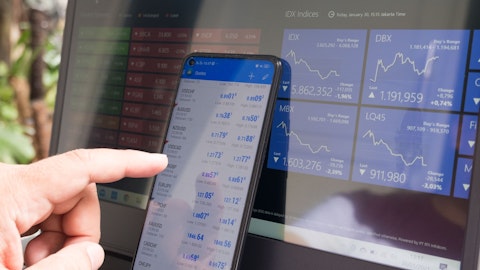In this article, we look at the 50 largest economies in the world ranked by PPP. You can skip our detailed analysis of the global economic dynamics and trends for the future, and head over directly to the 10 Largest Economies in the World Ranked by PPP.
Gross Domestic Product (GDP) is the market value of all goods and services produced in a country within a given time frame. In our previous article, 50 Largest Economies in the World in 2023, we ranked the largest economies based on their nominal GDP, a metric that accounts for current market value of a country’s output. On the other hand, GDP based on purchasing power parity, or PPP, measures the value of goods and services produced in a country with respect to another country’s currency – usually the US Dollar. The GDP based on PPP metric is widely used to gauge differences of economic productivity that exist between countries.
While the United States is the largest economy in the world in terms of nominal GDP, it is China which takes the number spot when ranked in terms of PPP. The United Nations has projected the world economy to grow by 2.3% in 2023. The United States economy is expected to grow 1.1% this year, in contrast to China’s GDP which is projected to expand by over 5%. Hopes of Europe’s economic recovery from the effects of the coronavirus pandemic remain dim amid Russia’s invasion of Ukraine. European economies, on average, are forecasted to grow by a mere 0.9% this year.
Economic experts have dubbed the 21st century as Asia’s century. According to forecasts made by the PricewaterhouseCoopers International Limited (PwC), the global GDP will grow 130% between 2016 and 2050. China alone will hold one-fifth of the share of the world’s GDP in terms of PPP by 2050, while India is tipped to surpass the United States to rank 2nd. You can read more about how the global economic order will shape up in the coming decades in our article, 20 Largest Economies in the World by 2050.
The McKinsey Global Institute highlighted in a report the impact that corporations have on the world economy. The findings state that about 72% of GDP in OECD member nations was contributed by the business sector. A major chunk of this percentage came from corporations that have more than $1 billion in annual revenue. Publicly listed companies like Apple Inc. (NASDAQ:AAPL), Microsoft Corporation (NASDAQ:MSFT), and Lockheed Martin Corporation (NYSE:LMT) have played a significant role in enabling the status of the United States as a global economic power.
Apple Inc. (NASDAQ:AAPL)’s revenue of $394 billion in 2022 was higher than the GDP of many countries in the world. Lockheed Martin Corporation (NYSE:LMT) is one of the largest defense companies in the world that provides sophisticated technological weapons to militaries around the globe, which helps inject money into the national economy. Microsoft Corporation (NASDAQ:MSFT)’s profits in the first quarter of 2023 ($18.3 billion, or $2.45 per share) are already 9% higher than the same period last year.
Since the last few years, a number of large western corporations have begun shifting their operations to Asia due to cheap labor and to tap into the large Asian markets. 95% of Apple Inc. (NASDAQ:AAPL)’s high-end products such as the iPhone, iPad, and Macbook are made in China. Microsoft Corporation (NASDAQ:MSFT) too has established data centers in several Asian countries – one of them in Indonesia, which the company expects will increase its revenues by $6 billion.
Asian corporations themselves contribute heavily to the global economy – at an average of $19 trillion each year. Alibaba Group Holding Limited (NYSE:BABA), Toyota Motor Corporation (NYSE:TM), and Taiwan Semiconductor Manufacturing Company Limited (NYSE:TSM) are some of the prominent Asian companies to have made a mark on the global stage.
Alibaba Group Holding Limited (NYSE:BABA) is one of the world’s largest e-commerce companies, holding a major share in China’s retail and wholesale markets. The group had a revenue exceeding $30 billion in the first quarter of 2023. On the other hand, Japanese car manufacturer Toyota Motor Corporation (NYSE:TM) contributes 11.5% share of the world’s annual automobile output. In the global foundry industry, Taiwan Semiconductor Manufacturing Company Limited (NYSE:TSM) accounts for nearly 60% of all production.
Let’s now head over to the list of the biggest economies in purchasing power parity.
Methodology
We have used GDP based on PPP for countries to rank the 50 largest economies in the world. The figures are from 2022 and were sourced from the International Monetary Fund (IMF).

Here are the largest economies in the world ranked by PPP.
50 largest economies in the world ranked by PPP
50. Ukraine
GDP (PPP): $441 billion
Ukraine is a lower middle income economy in eastern Europe. According to the World Bank, the Ukrainian economy, which shrunk by 30% in 2022 after Russia’s invasion, is expected to grow by 0.5% in 2023.
49. Israel
GDP (PPP): $500 billion
Israel is one of the most advanced countries in the world, and spends heavily on innovation and research and development. In 2022, its GDP, based on PPP, was measured by the IMF at $500 billion.
48. Hong Kong
GDP (PPP): $507 billion
Due to an increase in tourism and local spending, Hong Kong’s economy is expected to grow between 3.5%-5% in 2023 according to government forecasts. This is a recovery from last year when the economy shrank by over 4% in the last three quarters of 2022.
47. Czech Republic
GDP (PPP): $520 billion
The Czech Republic is one of the 20 largest economies in Europe. The country’s GDP based on PPP was estimated to be $520 billion in 2022.
46. Iraq
GDP (PPP): $521 billion
Iraq is one of the top economies by PPP. The Iraqi economy expanded by 8% in 2022, driven by an increase in the country’s oil output, and a global surge in prices of the commodity.
45. Peru
GDP (PPP): $524 billion
Peru’s GDP is expected to grow 1.7% this year, according to forecasts by the OECD. In 2022, the IMF estimated the size of its economy to be $524 billion based on purchasing power parity.
44. Chile
GDP (PPP): $579 billion
Chile’s GDP grew by 2.4% in 2022, driven by exports in lithium and copper. The size of the economy was measured by the IMF at $301 billion in nominal terms, and $579 billion in terms of PPP in 2022.
43. Algeria
GDP (PPP): $583 billion
Algeria had a GDP of $583 billion in PPP terms in 2022, because of which, the North African nation found a place in the 50 largest economies in the world.
42. Kazakhstan
GDP (PPP): $603 billion
Kazakhstan, the former Soviet republic, is the largest economy in Central Asia, having a GDP in PPP terms of $603 billion in 2022 according to the IMF. The World Bank has projected the Kazakh economy to grow by 3.5% in 2023, driven by abundant mineral resources extraction and a healthy FDI.
41. Austria
GDP (PPP): $605 billion
Austria is one of the biggest economies in ppp. It is currently going through an economic downturn. The country’s GDP is expected to grow by only 0.2% in 2023. The size of the Austrian economy was measured at $605 billion in PPP by the IMF last year.
40. Ireland
GDP (PPP): $687 billion
With a GDP growth rate of 12.2%, Ireland had the fastest growing economy in Europe in 2022. Much of this was driven by growth in exports, increased private consumption, and investments by multinationals.
39. Sweden
GDP (PPP): $689 billion
The Swedish government last year described its forecast for 2023 as ‘gloomy’. The economy is set to contract by 1% this year. Despite this, Sweden remains among the largest economies in the world, with a GDP, based on PPP, of $689 billion in 2022.
38. Singapore
GDP (PPP): $719 billion
Singapore is one of the top economies in purchasing power parity. It is a high-income country and has a GNI per capita exceeding $64,000. The country is a major financial and international trading hub. The Singapore Dollar is among the most traded currencies in the world – accounting for 1.8% of all daily trading in the foreign exchange market.
37. Belgium
GDP (PPP): $733 billion
Belgium is one of the most politically influential countries in the world, and hosts headquarters of international organizations like NATO and the European Union. The OECD has projected the Belgian economy to grow 0.9% this year. Its GDP based on PPP was measured at $733 billion in 2022 by the IMF.
36. Romania
GDP (PPP): $737 billion
Romania has one of the largest GDPs by PPP. Romania’s GDP grew 4.2% in 2022. Reason behind this robust growth was higher private consumption and increased investments in the country that year. The GDP in PPP terms is measured at $737 billion by the IMF.
35. Switzerland
GDP (PPP): $740 billion
One of the largest economies in Europe, Switzerland is estimated to have a GDP in PPP terms of $740 billion in 2022 according to the IMF. The country’s financial system acts as a safe haven for investors, which has helped the Swiss Franc to be one of the most traded currencies in the world.
34. United Arab Emirates
GDP (PPP): $828 billion
The Emirati nation’s GDP grew at 7.6% in 2022, and projections for this year are above 7% as well. The UAE government aims to double the size of its economy by 2031. It was recorded at $828 billion in terms of purchasing power parity by the IMF.
33. South Africa
GDP (PPP): $953 billion
Rising operating costs due to scheduled power cuts have constrained South Africa’s economy from reaching its full potential. Despite that the country remains an economic power in the African continent.
32. Colombia
GDP (PPP): $968 billion
Colombia’s GDP growth was recorded at 7.2% in 2022. However, it is expected to slow down this year to 1.7% according to the World Bank. In terms of PPP, the size of the country’s GDP is estimated to be $968 billion.
31. Malaysia
GDP (PPP): $1.13 trillion
Malaysia’s economy has grown by 5.6% in the first quarter of 2023, outperforming some other countries in the region, including China, Indonesia, and Vietnam. The IMF measured the size of the Malaysian economy at $1.13 trillion, based on purchasing power parity.
30. Philippines
GDP (PPP): $1.17 trillion
The Philippines’ economy has a GDP based on PPP of $1.17 trillion. PwC has projected the country to be among the 20 Largest Economies in the World by 2050. The economy is expected to grow 6.3% in 2023. According to the Asian Development Bank (ADB), the Philippines is on track to become an upper middle income economy.
29. Argentina
GDP (PPP): $1.22 trillion
Argentina has one of the biggest GDPs in purchasing power parity. It is currently going through one of its worst economic crises since independence, with inflation soaring past 100% and the central bank raising interest rates to 97%, in order to slow down economic activity to curb hyperinflation and incentivize investments in the local currency. Despite these challenges, it remains a strong economy in the South American region. In 2022, the IMF recorded Argentina’s GDP in PPP terms at $1.22 trillion.
28. Netherlands
GDP (PPP): $1.23 trillion
The Dutch economy grew at 4.3% in 2022, but is expected to slow down to 0.8% in 2023. Last year, the size of the economy in terms of purchasing power parity was measured at $1.23 trillion, making the Netherlands one of the strongest economies in the world.
27. Nigeria
GDP (PPP): $1.28 trillion
Nigeria has the largest gas reserves in Africa, and proven crude oil reserves of over 37 billion barrels. It is the largest economy in Africa. According to the World Bank, the Nigerian economy is projected to grow by an average of 2.9% between 2023 and 2025.
26. Vietnam
GDP (PPP): $1.32 trillion
Vietnam is one of the largest economies in the world by PPP. The IMF measured the size of Vietnam’s economy in PPP terms at $1.32 trillion in 2022. The country’s GDP grew at 8% last year, but the growth rate is expected to drop in 2023 due to the economic slowdown in the European Union and the United States – two of Vietnam’s largest trading partners.
25. Bangladesh
GDP (PPP): $1.34 trillion
Bangladesh’s GDP growth for 2023 has been projected to be 5.3%. This is the third highest growth rate among South Asian countries after Maldives and India. In 2022, Bangladesh’s GDP based on purchasing power parity was estimated at $1.34 trillion.
24. Thailand
GDP (PPP): $1.48 trillion
Thailand has seen a surge in tourism after easing travel restrictions in May 2022. This has helped the Thai economy in rebounding from effects of the Covid-19 pandemic. Compared to 1.4% in the final quarter of 2022, Thailand’s economy expanded by 2.7% in the first quarter of 2023.
23. Pakistan
GDP (PPP): $1.52 trillion
Pakistan is the fifth most populous nation in the world. The country’s massive market and a sizable youth population offers immense potential for the future. In 2022, Pakistan’s GDP in terms of purchasing power parity was recorded at $1.52 trillion by the IMF.
22. Iran
GDP (PPP): $1.60 trillion
Despite western sanctions, Iran’s economy manages to sustain itself due to its wealth in natural resources. The economy is forecasted to grow 2.2% in 2023. Iran ranks as the 19th largest economy in Asia in terms of nominal GDP. You can read more about other large Asian economies in our article, 20 Largest Economies in Asia. Moreover, the PwC has projected Iran to be among the 20 Largest Economies in the World by 2050.
21. Taiwan
GDP (PPP): $1.61 trillion
Taiwan is referred to as one of the four Asian Tigers along with Hong Kong, Singapore, and South Korea. The size of the Taiwanese economy was measured in PPP terms at $1.61 trillion by the IMF.
20. Australia
GDP (PPP): $1.62 trillion
Australia is the 20th largest economy in the world in terms of purchasing power parity, with a GDP of $1.62 trillion in 2022 as per the IMF. The Australian Dollar is the premiere currency of the Asia-Pacific region, and is the six largest trading currency in the world with a daily trade volume closing in on $500 billion in the foreign exchange market. You can read more on this in our article, 15 Most Powerful Currencies in the World.
19. Poland
GDP (PPP): $1.64 trillion
Increased energy prices and a large influx of refugees in wake of Russia’s invasion of Ukraine has taken a toll on Poland’s economy. The country had a GDP growth of 5.1% in 2022, but the projection for 2023 is a mere 0.7%.
18. Egypt
GDP (PPP): $1.67 trillion
Egypt had a GDP of $1.67 trillion based on PPP in 2022. The economy grew by 6.6%, but is expected to decline to 4.5% in 2023. According to the PwC, Egypt will overtake countries like Canada and Italy to become the 15th largest economy in the world by 2050.
17. Saudi Arabia
GDP (PPP): $2.15 trillion
Saudi Arabia is the 17th largest economy in the world, in terms of both nominal GDP, and GDP based on PPP. The kingdom is one of the largest exporters of oil in the world, and a founding member of OPEC.
16. Spain
GDP (PPP): $2.24 trillion
Spain’s GDP is expected to grow 1% in 2023. This is a drop from 5.5% in the previous year. According to the IMF, Spain’s economy is worth $2.24 trillion in terms of purchasing power parity.
15. Canada
GDP (PPP): $2.26 trillion
Canada is the 15th largest economy in the world in terms of PPP. The IMF in 2022 estimated the GDP of Canada at $2.26 trillion in PPP. The Canadian Dollar is the seventh most traded currency in the world, with a daily trade volume of $460 billion in the forex market.
14. South Korea
GDP (PPP): $2.77 trillion
South Korea had a GDP growth rate of 2.6% in 2022, which is expected to decline to 1.6% in 2023 due to an economic slowdown in the electronics industry. Despite that, South Korea is among the fastest growing emerging markets in the world, and in 2022, the size of its economy was measured at $2.77 trillion.
13. Mexico
GDP (PPP): $2.95 trillion
Mexico is one the biggest trading countries in the Latin America region. The PwC has projected Mexico to be the seventh largest economy in the world by 2050. Currently, it is the 15th largest in terms of nominal GDP, and 13th in the world ranked by PPP.
12. Italy
GDP (PPP): $3.05 trillion
Italy is an economic powerhouse in Europe, boasting a GDP based on PPP of $3.05 trillion in 2022, according to figures shared by the IMF. The Italian government expects the GDP to grow 1.2% this year, above the initial target of 1%.
11. Türkiye
GDP (PPP): $3.35 trillion
Turkey is a member of the G20 and OECD. In 2022, the size of the Turkish economy based on purchasing power parity was measured at $3.35 trillion by the IMF. Despite the Turkish Lira taking a beating in the last few years, the economy remains strong. The GDP expanded by 5.2% last year.
Click to continue reading and see the 10 Largest Economies in the World Ranked by PPP.
Suggested Articles:
- 30 Most Important Economies in the World
- 20 Largest Economies in the World by 2050
- 30 Biggest Economies in Africa
Disclosure: None. 50 Largest Economies in the World Ranked by PPP is originally published on Insider Monkey.





